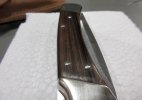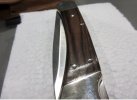-
The BladeForums.com 2024 Traditional Knife is ready to order! See this thread for details: https://www.bladeforums.com/threads/bladeforums-2024-traditional-knife.2003187/
Price is$300$250 ea (shipped within CONUS). If you live outside the US, I will contact you after your order for extra shipping charges.
Order here: https://www.bladeforums.com/help/2024-traditional/ - Order as many as you like, we have plenty.
You are using an out of date browser. It may not display this or other websites correctly.
You should upgrade or use an alternative browser.
You should upgrade or use an alternative browser.
110LE Blonde Ebony???
- Thread starter sassafrassdogs
- Start date
- Joined
- Aug 23, 2019
- Messages
- 881
Nice streaks.
bertl
Gold Member
- Joined
- Feb 17, 2011
- Messages
- 2,451
There is a line in Orwell’s “Animal Farm” that says, “Some are more equal than others.” I guess the same applies to ebony, “Some are more ebony than others.”
The ebony used by Buck for the early 110s was Macassar Ebony, also known as Striped Ebony. The ebony being used now is African Blackwood. The two woods are in completely different plant families. Macassar Ebony (Diospyros celebica) is in the legume or pea family and is known for having light stripes. Gabon Ebony (Diospyros crassiflora) is in the same family but is known for being pretty much all black.
African Blackwood (Dalbergia melaxylon) is in the ebony family, which also includes rosewood and cocobolo. Like Gabon Ebony, African Blackwood is pretty much all black, even though the two are not related.
We shouldn’t consider one better than the other, just different.
Bert
The ebony used by Buck for the early 110s was Macassar Ebony, also known as Striped Ebony. The ebony being used now is African Blackwood. The two woods are in completely different plant families. Macassar Ebony (Diospyros celebica) is in the legume or pea family and is known for having light stripes. Gabon Ebony (Diospyros crassiflora) is in the same family but is known for being pretty much all black.
African Blackwood (Dalbergia melaxylon) is in the ebony family, which also includes rosewood and cocobolo. Like Gabon Ebony, African Blackwood is pretty much all black, even though the two are not related.
We shouldn’t consider one better than the other, just different.
Bert
bertl
Gold Member
- Joined
- Feb 17, 2011
- Messages
- 2,451
From what I understand, the “best ebony” is that which is completely jet black with no blond streaks.
We get to thinking that pure black is the best, but maybe that's what we are conditioned to think. The pure black has had a lot of uses, many of them for musical instruments—piano keys, clarinets, guitars—and as thin decorative inlays, but that doesn't mean "best". For some uses the Striped or Macassar Ebony has been considered more interesting and "better".
- Joined
- Jul 21, 2016
- Messages
- 3,050
They say the guitar players favor the blonde ebony on the body and the black on the neck.....
BuckShack
Gold Member
- Joined
- Jul 19, 2015
- Messages
- 3,389
There is a line in Orwell’s “Animal Farm” that says, “Some are more equal than others.” I guess the same applies to ebony, “Some are more ebony than others.”
The ebony used by Buck for the early 110s was Macassar Ebony, also known as Striped Ebony. The ebony being used now is African Blackwood. The two woods are in completely different plant families. Macassar Ebony (Diospyros celebica) is in the legume or pea family and is known for having light stripes. Gabon Ebony (Diospyros crassiflora) is in the same family but is known for being pretty much all black.
African Blackwood (Dalbergia melaxylon) is in the ebony family, which also includes rosewood and cocobolo. Like Gabon Ebony, African Blackwood is pretty much all black, even though the two are not related.
We shouldn’t consider one better than the other, just different.
Bert
https://www.taylorguitars.com/ebonyproject/
From what I've read, Buck is using West African ebony (Diospyros crassifloria) which is Gabon Ebony grown in Cameroon by Taylor Guitars. I have not found any reference of African Blackwood being used.
bertl
Gold Member
- Joined
- Feb 17, 2011
- Messages
- 2,451
From what I've read, Buck is using West African ebony (Diospyros crassifloria) which is Gabon Ebony grown in Cameroon by Taylor Guitars.
I think you may be correct—my apologies for bad information. However, we still should not think of one ebony as inferior to another.
Bert
BuckShack
Gold Member
- Joined
- Jul 19, 2015
- Messages
- 3,389
I agree. Here is a good video I enjoyed from the site above.I think you may be correct—my apologies for bad information. However, we still should not think of one ebony as inferior to another.
Bert
- Joined
- Mar 31, 2018
- Messages
- 2,726
They say the guitar players favor the blonde ebony on the body and the black on the neck.....
That is correct. The finger board/ fret board receives a lot of wear as the strings are pressed and contact the board while playing. The black wood is favored not just for color but also because it is very dense and hard having a longer service life. As for the guitar body it depends on what tone or sound is desired and usually is a hardwood for good resonance but the top face can be a tight grained spruce that gives a sharpener projection or a solid cedar that gives a warmer tone.
I have a 1984 Alvarez Yari DY63 guitar that the finger board is a brownish black ebony on a burled mahogany neck with the body sides and back made with Ovangkol, the face top is cedar that gives a warm tone. After playing it for 32 years it does have some slight wear on the finger board in the most commonly used cord areas and the brass frets are worn down almost ready for new ones but it is still in very good shape.
Jet black ebony is known to be very dense and hard but there are some other lighter colored woods that are also very dense and hard that wear very little. It also depends on the finish sealer that is applied and the humidity or dryness that the guitar is exposed to.
I think in the last 30-40 years or so since the regulations and bans on exotic woods that many manufacturers have had to change their way of thinking towards exotic woods and that conventional wisdom wasn’t always spot on. Now they use a more frugal and conservative type of wisdom that allows them to still produce excellent instruments without the waste.


